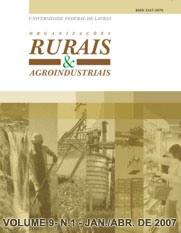Determinants for foot and mouth disease eradication in Brazil
Keywords:
foot and mouth disease, Brazil, discriminant analysis, livestock, PNEFAAbstract
Foot and mouth disease (FMD) has been a problem for the Brazilian livestock since the XIX century. Once it affects the livestock productivity and has always been a problem for the country exports due to the imposition of sanitary barriers. In 1992, when no state was free from FMD, the National Program for Eradication of FMD (PNEFA) was implemented. Since then good results has been obtained with control and eradication of the disease in some states. However, in other states the problem still persists. It is important to determine why some states have faced difficulties in reaching the status of free from FMD while others not. This work aimed to identify the factors which discriminate the populations of states free from FMD from those not free. The results showed that the private efforts in controlling the disease are the most important variables for differentiating the states free from the non-free ones, together with the lack of public investment. The bad climatic conditions of most of the non-free states seem to contribute to the lack of interest to eradicate the disease. It is suggested attention of the authorities in relation to the state of Alagoas which has presented sufficient scores to be considered free from FMD.


